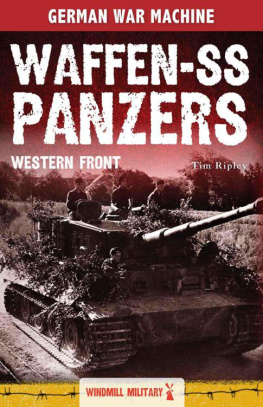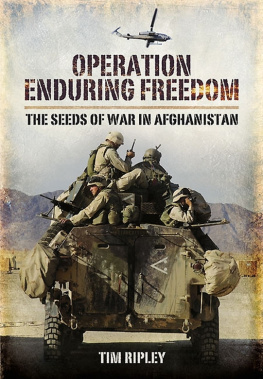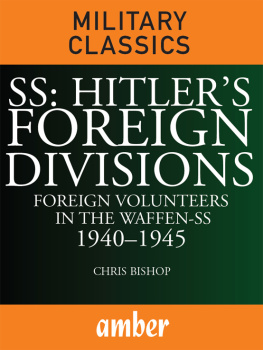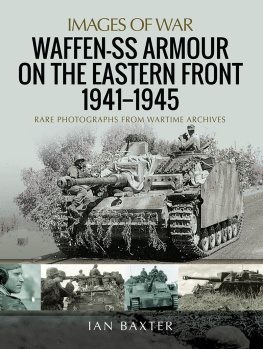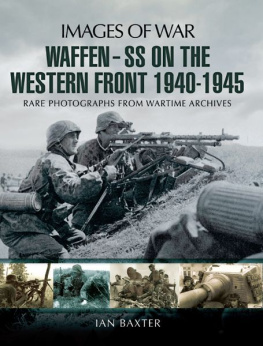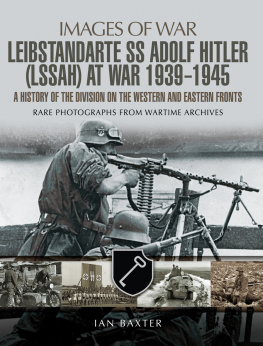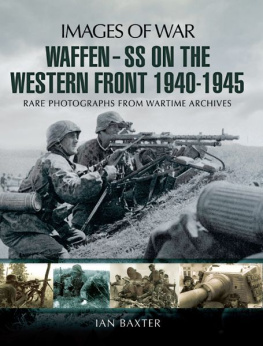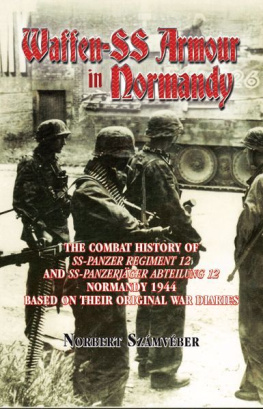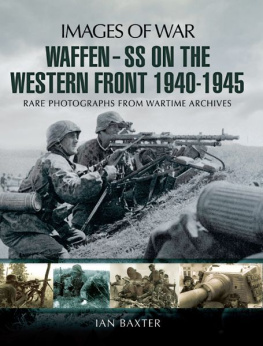Tim Ripley - Waffen-SS Panzers The Western Front
Here you can read online Tim Ripley - Waffen-SS Panzers The Western Front full text of the book (entire story) in english for free. Download pdf and epub, get meaning, cover and reviews about this ebook. year: 2014, publisher: German War Machine, genre: Non-fiction. Description of the work, (preface) as well as reviews are available. Best literature library LitArk.com created for fans of good reading and offers a wide selection of genres:
Romance novel
Science fiction
Adventure
Detective
Science
History
Home and family
Prose
Art
Politics
Computer
Non-fiction
Religion
Business
Children
Humor
Choose a favorite category and find really read worthwhile books. Enjoy immersion in the world of imagination, feel the emotions of the characters or learn something new for yourself, make an fascinating discovery.
- Book:Waffen-SS Panzers The Western Front
- Author:
- Publisher:German War Machine
- Genre:
- Year:2014
- Rating:5 / 5
- Favourites:Add to favourites
- Your mark:
- 100
- 1
- 2
- 3
- 4
- 5
Waffen-SS Panzers The Western Front: summary, description and annotation
We offer to read an annotation, description, summary or preface (depends on what the author of the book "Waffen-SS Panzers The Western Front" wrote himself). If you haven't found the necessary information about the book — write in the comments, we will try to find it.
Tim Ripley: author's other books
Who wrote Waffen-SS Panzers The Western Front? Find out the surname, the name of the author of the book and a list of all author's works by series.
Waffen-SS Panzers The Western Front — read online for free the complete book (whole text) full work
Below is the text of the book, divided by pages. System saving the place of the last page read, allows you to conveniently read the book "Waffen-SS Panzers The Western Front" online for free, without having to search again every time where you left off. Put a bookmark, and you can go to the page where you finished reading at any time.
Font size:
Interval:
Bookmark:
- Appendices

Unit identifiers are located on the right-hand side of the unit symbol. The upper line is the unit number, or an abbreviated version of the units name if it did not have a number (eg. RTR for the Royal Tank Regiment, Gds. for the Guards Armoured Division, or Pz. Lehr for the Panzer Lehr Division). The lower line contains additional information about the unit. This can be the nationality of the unit for British commonwealth armies (Pol. for Polish, Can. for Canadian, and Brit. for British), or an indication of its type (eg. SS for Waffen-SS, VG for Volksgrenadiers or AG for Assault Gun). Ad hoc formations are marked with the abbreviation TF for Task Force (US) or KG for Kampfgruppe (German). The symbol (-) indicates that one or more of a formations component units had been detached.
Occasionally there will be a set of numbers on the left-hand side of the symbol. These indicate the parent unit (if marked on a regiment, for example, they would indicate the brigade that the regiment was part of).
Each chapter of this book opens with a high-quality contemporary photograph. Click or tap on the photograph to see a detailed caption, then click or tap on the 'return' link to go back to the chapter. If your e-reader does not allow internal links, the caption pages can usually be found at the very end of the book, beyond the imprint page.
The maps used in this book are high-resolution images, so on reading systems where zooming is supported it should be possible to examine them in detail by clicking or double-tapping on them. We cannot guarantee easy readability on older readers or readers with relatively low-resolution screens, however. If you are unable to examine the maps in detail, high quality versions, along with other additional content, can be found at www.germanwarmachine.com
This book is dedicated to the heroes of the US Armys 291st Engineer Combat Battalion, who at the moment of crisis blew the strategic bridges on 18 December 1944 to stop the advance of SS-Obersturmbannfhrer Jochen Peipers Kampfgruppe at the height of the Battle of the Bulge. Men like Corporal Fred Chaplin, who pushed the plunger to blow the bridge at Habiemont as Peipers tanks bore down on him, were in the vanguard of turning back Hitlers Waffen-SS panzer lite, so freeing Europe of Nazi tyranny for good.
The author would like to thank the following for their help during the researching and writing of this study: Neil Tweedie and Micky Brooks for their assistance in providing an understanding World War II Blitzkrieg strategy; the records staff of the Imperial War Museum in London for their help with research into German World War II documents; the British Army Staff College, Camberley, for allowing me access to rare German World War II records in their possession; Stewart Fraser for proof-reading my text; Pete Darman, of Brown Partworks, for at last giving me the opportunity to fulfil my long-held ambition to write about the Waffen-SS; and, last but not least, Major Hasse Resenbro of the Danish Guard Hussar Regiment for his help retracing the escape route of Kampfgruppe Peiper from La Gleize.
Christmas morning 1944. Just under 800 cold and half-starved Waffen-SS men emerged from the morning gloom to pass through the frontline German trenches to safety. At their head was the charismatic 29-year-old SS-Oberstrmbannfhrer Jochen Peiper, who had led them for almost two days through thick woods, pursued by American patrols and spotter planes. The Waffen-SS officer was still joking with his men, slapping their backs and encouraging them to keep moving.
Only eight days before, Peiper had led a Kampfgruppe (battle group) of some 5800 men forward into battle. They had at first swept all before them, penetrating deep behind enemy lines, before their luck and petrol had started to run out. Captured American petrol dumps kept Peipers 100 Tiger II, Panther and Panzer IV tanks moving for the first few days of Operation Autumn Mist, as the Ardennes Offensive had been codenamed by Hitler. In the heady days of the advance, the Kampfgruppe ensured its eternal notoriety when it machine-gunned a group of unarmed US Army prisoners of war in a field outside the town of Malmdy.
Peiper drove his men hard. He was often seen at the head of his huge column of tanks and vehicles, sorting out traffic jams, or exhorting them to attack yet another American position blocking their route to the River Meuse, the 1st SS Panzer Division Leibstandarte Adolf Hitlers objective.
Heavy mist, snow slurries and incessant rain kept the Allied fighter-bomber squadrons at bay most of the time, but it made life miserable for the Waffen-SS men, shivering in their freezing tanks or open SdKfz 251 armoured halftracks. Few men got any sleep as the column weaved its way along single track roads and around hairpin bends. The key to victory was the handful of bridges that crossed the swollen rivers of the Ardennes.
The bad weather and the element of surprise worked in Peipers favour for the first couple of days. They stormed past confused and disorganized American troops, capturing bridges and supply dumps with ease. One US general was just able to flee his command post less than half an hour before the arrival of Peipers panzers, much to his chagrin.
As the Americans regained their composure, they started to rebuild their defences. Time and again, Peipers men found their route blocked by dug-in and determined defenders. On three occasions, for example, the Americans managed to blow up a vital bridge just as a group of Waffen-SS panzers was coming into view. Slowly Peiper found his options being closed down, one by one.
A week into the advance, Kampfgruppe Peiper was badly battered by almost constant fighting. Its ammunition and fuel was nearly exhausted. The 1000 or so men still capable of fighting had not eaten a proper cooked meal since they had left Germany on 16 December, at the start of the attack. Peiper realized his attack had run out of momentum and started to pull his men back to the hilltop village of La Gleize to make a last stand. American tank columns were pushing against his force from the west, north and east. The Luftwaffe attempted to make a supply drop to the beleaguered Waffen-SS men, but most of the containers of ammunition and petrol ended up behind American lines. Peiper repeatedly radioed his divisional commander, SS-Oberfhrer Wilhelm Mohnke, asking for permission to break out.
La Gleize had been turned into a fortified strongpoint by Peipers men. Tiger II tanks with massive 88mm cannons blocked all the approach routes, making it impossible for the lightly armoured US Shermans to get through. Waffen-SS panzergrenadiers were posted in the woods around the town to stop US infantrymen infiltrating. Attack after attack was repulsed with heavy American losses. The solid Belgian houses of the village made safe havens from the almost hourly American artillery bombardments that were raining down on La Gleize. Hundreds of captured Americans were hiding in the cellars, alongside the steadily increasing numbers of German wounded. Peiper was often seen touring the improvised field hospitals to raise morale among his boys. The English-speaking Waffen-SS officer struck up a rapport with a senior American prisoner, Major Hal McCowan. Even as he was planning the escape of his decimated Kampfgruppe, Peiper was still maintaining to McCowan that Germany was winning the war and that the Fhrers new secret V-weapons would turn the tide of the conflict in the Third Reichs favour.
Font size:
Interval:
Bookmark:
Similar books «Waffen-SS Panzers The Western Front»
Look at similar books to Waffen-SS Panzers The Western Front. We have selected literature similar in name and meaning in the hope of providing readers with more options to find new, interesting, not yet read works.
Discussion, reviews of the book Waffen-SS Panzers The Western Front and just readers' own opinions. Leave your comments, write what you think about the work, its meaning or the main characters. Specify what exactly you liked and what you didn't like, and why you think so.

